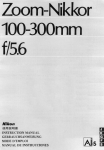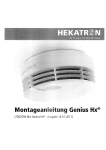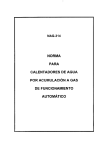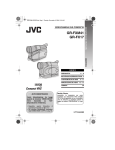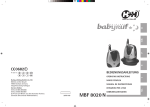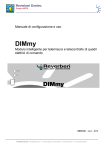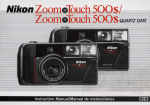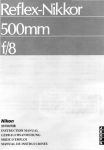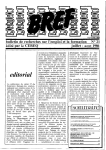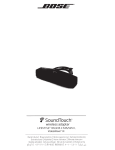Download Nikon Nikkor Af 35-70mm F/3.3-4.5 Zoom Macro Lens Slr Film Or Digital Camera - Zoom-Nikkor%2035-70mm%20f-3.3
Transcript
Zoom-Nikkor
35-70mm
f/33-4.5
Nikon
INSTRUCTION MANUAL
BEDIENUNGSANLEITUNC
MANUEL D'UTILISATION
MANUAL DE INSTRUCCIONES
MANUALE Dl ISTRUZION1
[~]jj~| m
LMs
O
0|
rj
[J
***-**.
* ,
#«?<»*»
I K'Jtt*
9 mwi>^
2
10 E E S B t f - f
7 # n $ I « 5 •OCS.%)
3 E«i«/»*K«sa*»»
4 sastsffi
K(DS-IZttF2AS*j<7K)
II BBitaum
7 *.««6«as
i2 7 r - f > y — i « j * * » R y i S
i3 Ba»F(ia»#-i' K
i4 «<J a®
15 BWItJUJ^-f K
8 x— s > * • ' ; > y
16 »IJ 'J >«*
5 *#t-}§«
6 7 ^ - * > > •V') > y
ttL'»U
!
ZOTfct/li, - •y 3 - J H / > x«-fcm>-tuvfcK#s>'.i* £5 :-?i'j-r. cm
U > X [ J - q > F V ^ > hOT*> 7 * f < C t f T i ^ t f f W i t . t f c , TTL
BUW- (F-40l7j;<5£P*<)
i MB Lxmtamwfri-1t.
c m u > X i t , i S l f t m i - >zma.frhAi,nmtT-®.n.- aw** | . # X - A
1 - > « T . * ^!E«IJJSft35nim*-lbaa70«miT-ff3S«S-*'"t-L. M t H f E
» 0 . 5 m . S Cjl; 7 7 P « i c i i)o.35m(S*}l»1S* i :«.») j x - m a s a K J ' T
**T„
tfc,
« * L - > JfCftfrStt » X - i U > X t L T f l f f l T 4 : i : t i T - # ,
—«E*
»B, ^^-•^•?j|»t,%>bA. «i*tt-a¥'i4OT9*sn?.«a¥« • ie*¥«.
S ^ T E - B * U f<7)S?*tiC;^fflifii:*ter 5 : c A<T* t 1 .
J >;?'£ t" > 1 - • & * ? * ( * , H4AIJ > « f f i 2 • ( * » * * » « LTfc'K 3 ^
c > l l 3 - f < >i>'fi'^%iizM£tiTmtzif>yi'T—
• 3 — ?, K75d--'j;i>H*
tfWbti, ftroSK'ttfeSS-cflilStt-c^i-t.
X-
u > X m K U S * OR*) t * > » # 7 " ' - f » J U > X » « t » # i : * # i t j « T . 1->X
#'«rOA-AT-U>X«rSa#lt751*1 UEHA"bJiT) U I H L J T . K'J U"f T i S l i ,
* J> 7*T'<cnj»IJ4*? >*#L'.cA , '= u>x«riepit^-fnii;ia L. i t ,
rut
• Ai7?3tx-attiIta»u"'-* ! "*-tifSm*y ? * r - r i;ccnu>x^8JU«lt
5*&tt. *> 5*x-f
OTBStt-iBBllw'C-A'jELuttllirASjMiBL-tBl';
H*R
English
Depth-of-field scale Deutsch
Scharfentiefeskala
Franpais
Echelle de profondeur de champEspanol
Escala de profundidad de campoItaliano
Scala profondita di campo-
•41
-45K
- Page 10
- Page 45
-Seite 16
- Seite 45
- Page 23
- Page 45
-Pagina 29
- Pagina 45
• Pagina 36
Pagina 45
tt»T<tz2l\
tit. «*a5TTLHatt#S*J'5il«f-f CJ*M #»»»*-»,
B
SrEl
•=.>?
X - ; : > y ' J > y S - i a L T X - i > y $ - m \ **ffiK«*.'S!E!KSWi:'&Tfct
C-%*!it*15'J * T . « , f i ! 6 » l a ® « , 3 5 ~ * - ' b 7 0 ™ * T 3 * ft (T> B &tfMf!> S H
ZC0U>X<7>t*i;!Btl«, i I $ f » » T - « S S (oo) * - c , 0 . 5 m t T - t i i ' - 3 T l . > J T „
S "i l ; i f i * » » ( v ? n » » )
PKs*5:i:s!x-j*r.
frS-5«-&l;W,0.5m%axT73—
;<73ts.
»-»y'J>y%
ea«»!ii«it0.35mt««v#p5SJt%
v y p « » 5 £ f f - j : : t A < T - ? . ( l / « B » 7 0 « " T * * « » « H » i :4.4. «,«!§«35".m
x-t»iK(e*i: s.3f>m^ntr.
<IL. ®*.sf§»iflj-cv?pi(if2£m>j:-f
is
a f i w E T ^ c t * * ' ) s t m t . x-$umAm&mmmx-iDz-mmitit
7 7 -r > y - * y y - > t ro«*-e-fc*
= a >F3-> y - * « 1 t/F2-> 'j - x c a * « « O T 7
7
< > y - 7. y y - > * < » y ,
> / < - > - i t g l f l ^ a > / t — » - T C - t D I S . 200. TC-l4AST-f„
A/L B C D E Gl G2 G3 G4 HI H2 W W J K / P M R T U
_F3_
F2
• a x t - a y ' < - # - T C - 2 0 0 J f c ( i , TC-201S4-*j»L/c«§
_7.1><>--s
»>5
^^—_
A/L B C D E Gl G2 G3 G4 HI H2 H3 H4 J K/P M R T|U
•©
F3
• • • »|
•• V
8
F2
• <>. e
•a?^a^'<-^-TC-l4AS«r8»Lfc«-&
w-> A/L B
c D E Gl G2 G3 G4 HI H2 H3 H4 J K/P M R T U
9
F3
m
(•; 0*
F2
©
•
* @
• W E < a * £ * e > (••g-fc-ttroiifticti
•—
e.
s
o
a(M:«ffl^aax-r„
•S-h*%#mLT < fc#l.>. (K2,B2.E2*;> 'J - X J ^ t t ^ ' f t K . B . E * # U-><7>
MSFfflWSE-lbCouT
<T)i. TlCIHJSFffl*!3.3*-'b4.5C^-|tLtT„ *,S!§«t*!35™m t * F3.3, 70i"OT
£*F4.5£4''K « 5 / 6 S S - | t L * - r „ T T L S W I t # # * / v * T ' - f M*ffl-f 3i*-&
iiMMF««!^-(tLTfciH'i:Bta«-»'bniT*<,
*aaait«-ffiffl-r-s£*<c
*,^!i«35«"mt siittemlSt'Htfflti;. 70n™«i sit3fSOT«ti;ffi«icR'; i f f l
(El I )
45
(13.9)
M 33
F
;
35
50
- MMfm
70
sMmmmmmmmamamm
i C l T M B < fc'<H>„
• T T L a t t n * » » % f f T * ^ ( S B - l 2 , 15, I6A, I6B, 17, 20<MSH*S)HaMFf«m
'Jfia'g'ft'tafc*. M*iBSHEB*tffi'ftL*TOT-t-;3iSLT< «*>.«,
• W l t t M * • 7 ; 3 7 ) i - i B i S i » g x f - Kv-f t-MftFtefc-g-fctf ?>«
s c i i a t r - t-^-r n»*Fffl«-(H i )msa«F«s:<t«-#RBLTis8iiLtr,
• FG-20t>L <(JEM, JiilfSB-ISfcL < tiSB-EMl*'£':b-ttTf£fflT4*-&SBI9(*^E— K-bU#^-4- r AjlC, SB-E(J*>^1zU##-4- r Ajifc(i r FE-FMj
l;T5£(?J5OTJ: •3l:LT(J(riaiE''j:SiiJ* ! *'bn*'r„ — 75,SB-l9£rBj,SEES-rBj *fclJ r EMjl;LT(!6ffl-ri)i. * - « >#'(; J; T TIHSFffl^Elt-T 5
fc»ais«i («,sffi»i70") T(tigjEam*!f»%nt-r«s, /SMS (**!EBt35
* f * 5 - 4 f ) Tit, Sffl±-ffifflT5Ctlt^UST-T*!,
is>)&»$9 >%^-3*> v*?-f Tit, mua**?
7ffi-M*l-7
>ini**<«>**»»«
ffifflff] : S.SSE»35™, « * * « • I mOTi*^
Eff)35mmmtt,Sic[lm_hsss^'&h«, HOT I m a t - 6 % a r o + * f t # i c
* * > * i t a « K u >XmgIJ * ! f/22(se«»')JBfflf fcffiffl) T-* Wi'E]
mft*ro22m»S*













































